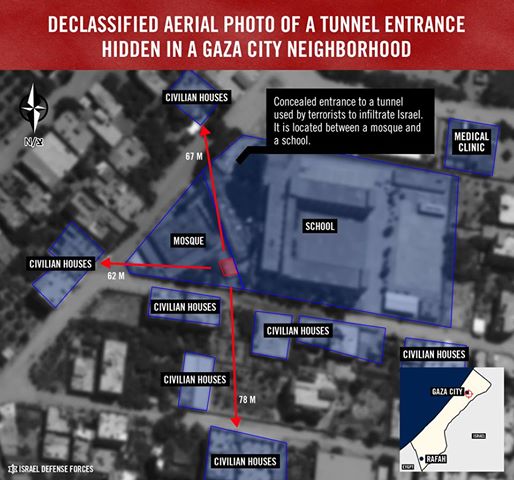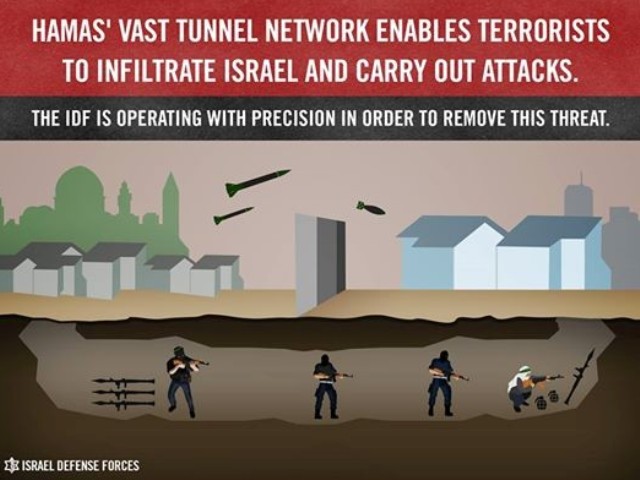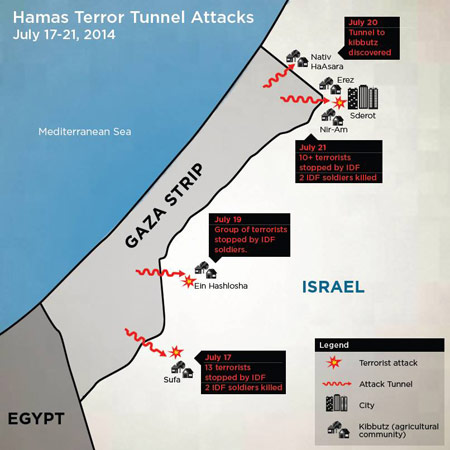Hamas has built an extensive network of tunnels that run from the Gaza Strip to Israeli territory. The tunnels are used by groups of terrorists to cross under the border to try and carry out attacks, murdering and kidnapping Israeli citizens.
Since the beginning of Operation Protective Edge, IDF has discovered 23 tunnels, some of which had exit points inside Israeli territory. The rest are used for other terrorist purposes.
Attack tunnels are dug starting at a site hidden within the Gaza Strip, most often private homes, greenhouses or public buildings. They then make their way underground for up to two kilometers (approximately a mile) until they reach their destination deep inside Israeli territory.

In recent years, the Gaza Strip has seen a boom in construction projects. However these projects are largely invisible to the naked eye since most of them can only be found underground.
The Hamas tunnel industry used to be a well-known conduit for smuggling weapons, goods, funds and even terrorists into the Gaza Strip, mostly from the Sinai Peninsula in Egypt. But the smuggling tunnels have been largely closed by Egypt. Now Hamas and the other terror organizations in Gaza are using their tunneling know-how and resources for a far more sinister purpose: terrorist attacks on Israeli territory.
The terror tunnels are far more sophisticated. They are much longer, deeper and more difficult to uncover. They are well-equipped with electrical and communication devices. Terror tunnels can take a year or more to complete and require significant financial resources, engineering knowledge, manpower and supplies (a single tunnel can require up to 500 tons of concrete).

Hamas terrorists infiltrate Israel through tunnels in order to stage deadly attacks aimed at killing and kidnapping Israelis.
Hamas terrorists infiltrated Israel several times through tunnels during Operation Protective Edge with the aim of
killing and kidnapping Israelis, as evidenced by the weapons, plastic handcuffs and
anesthetics seized from the terrorists who managed to infiltrate Israeli territory:
1. Early in the morning of 17 July, 13 Hamas terrorists emerged from a tunnel only 1.5 km (less than an mile) away from Sufa, a kibbutz (agricultural village) near the border with the Gaza Strip. Fortunately, they were discovered by the IDF before they could invade the village. Some of the terrorists were injured, while others succeeded in escaping. Two Israeli soldiers were killed by the heavily-armed Hamas terrorists.
2. On 19 July, in another attempt to harm Israeli civilians, a group of Hamas terrorists crossed under the border and emerged 700 meters (765 yards) from Kibbutz Ein Hashlosha. Again, IDF soldiers identified the group in time and prevented them from attacking the village.
3. On 20 July, a massive terror tunnel was discovered by IDF forces 170 meters (186 yards) inside Israel, near Kibbutz Nativ HaAsara. Residents of the village had to stay indoors and lock their doors and windows until it could be confirmed that no terrorists had used the tunnel yet.
4. On 21 July, more than 10 heavily-armed terrorists infiltrated Israel through another tunnel. They were planning to split into two groups: one to attack Kibbutz Erez and the other Kibbutz Nir-Am. The terrorists were wearing IDF uniforms to deceive civilians and Israeli security forces. Ten of the terrorists were killed by IDF. Four IDF soldiers were also killed during the battle.

The day before the start of the operation, another disaster was averted when a large terror tunnel near the Gaza border was uncovered and destroyed (7 July) before it could be used.
Hamas utilized this method as early as 2006. The terrorist organization used a cross-border tunnel to attack Israel, killing two IDF soldiers and kidnapping a third, Gilad Shalit, who was held by Hamas for five years.
Hamas also uses tunnels to carry out attacks by transforming them into giant landmines. This method consists of digging a tunnel which ends underneath a civilian site, such as a kibbutz or village, or a military post. Explosives are crammed into the tunnel, and detonated at will. This type of tunnel was detonated near the Gaza border fence in November 2012.
In October 2013, the IDF discovered the opening of a tunnel near the Israeli community of Ein Hashlosha. The tunnel, which stretched into Israel from the city of Khan Yunis in Gaza, was approximately 1.7 kilometers (approximately 1 mile) long and 18 meters (59 feet) deep, and was equipped with electricity and phone lines. It took Hamas more than a year to complete and required significant engineering know-how, manpower and supplies.
In a twisted set of priorities, Hamas invests huge
funds in the construction of this underground network of tunnels and
bunkers, instead of providing for the needs of the population in Gaza. Gaza's tunnels are literal money pits: a malevolent underground city built for the sole purpose of terrorism, emptying the already depleted coffers of the people of Gaza.
The tunnels also require a great deal of tangible resources. A single tunnel can use up to 500 tons of concrete and cement. Israel estimates that Hamas and the other organizations in Gaza have prepared dozens of terror tunnels.
The concrete used in these tunnels could have built bomb shelters for great numbers of Palestinian civilians. Instead, Hamas prefers that the civilians remain aboveground and unprotected. It is clear where Hamas' priorities lie: killing and kidnapping Israelis is far, far more important to this terrorist organization than protecting its own civilians.